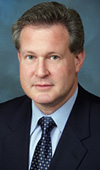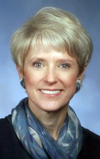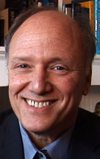UCSF's Unusual Thinkers to Appear at Dreamforce 2010

Robert Lustig
By Patricia Yollin
Robert Lustig considers himself an unusual thinker. But he said he’s far from alone.
“So is everyone here at UCSF,” said Lustig, MD, a pediatric endocrinologist. “People who research issues are that way by definition. We don’t necessarily believe the status quo. And that’s why we do what we do.”
Lustig and six other UCSF luminaries will appear at Dreamforce 2010, a cloud-computing event from salesforce.com founder Marc Benioff, on Wednesday, Dec. 8 at San Francisco’s Moscone Center. Benioff and his wife, Lynne, contributed $100 million to help build a children’s hospital at UCSF Mission Bay that will open in 2014.
Dreamforce is expected to draw 20,000 people, including former President Bill Clinton as keynote speaker. Most will be users and developers. However, one session, “Unusual Thinkers: The UCSF Track” represents a departure for the eighth annual conference.

Mark Laret
Mark Laret, chief executive officer of UCSF Medical Center, will discuss the future of health care. Then six experts in their fields will have 30 minutes apiece to possibly change how members of the audience approach their own health care.
Despite a prodigious string of awards and accomplishments, these UCSF innovators have all experienced the usual struggles of everyday life. But they’ve responded in unusual ways.
“I was a 5-foot-6 Asian kid who grew up playing the violin and piano,” said Anthony Luke, MD, 40, a primary care sports medicine specialist. “But I just loved basketball.”

Anthony Luke
In high school, he started practicing the sport at every opportunity. In junior year he tried out for the team at Lisgar Collegiate Institute in Ottawa and made it to the final cut. He worked so hard the coach kept him on. In senior year Luke qualified outright and was chosen by his teammates as most valuable player.
“I was really proud of that,” said Luke, an associate professor of clinical orthopaedic surgery. “It’s the kind of philosophy I’ve tried to impart to my patients: To not give up on their problems no matter how bad they are or how many other doctors they’ve seen.”
At Dreamforce, Luke and Thomas Vail, MD, professor and chair of the UCSF Department of Orthopaedic Surgery, will focus on peak performance. Vail can discuss tissue engineering and the science of stem cells all day. But he’s just as eager to talk about something he practices himself: cross-training.

Thomas Vail
“It’s what I tell my patients,” said Vail, 51, who uses an elliptical trainer, runs, hikes around San Francisco and plays golf.
“To people who are reluctant exercisers, to be told you can do a little bit of this and a little bit of that—a whole menu of things—is less daunting,” he said. “For the most part it’s a revelation.”
Lustig’s topic will be “Sugar: The Bitter Truth.” It is also the title of his 2009 lecture on the obesity epidemic, which has attracted more than 673,000 hits on YouTube. He likes the hits but not always the comments.
“One person said, ‘Why is this fat guy telling people what to do? Let him fix himself first.’ But it’s about the message, not the messenger,” said the 53-year-old head of the pediatric obesity program at UCSF.
His message is clear: Sugar has helped create a public health catastrophe. It causes significant insulin resistance at the level of the liver and drives the pancreas to make extra insulin.
Lustig is 5-foot-11 and weights 223, which is 20 to 30 pounds too much, he said. He loves a good steak and his weakness is almonds. But he hasn’t had a soda in more than 20 years, and his daughters, 5 and 11, are happy with water and milk.
Asked if people are self-conscious around him in social situations, he said, “Yeah, a little. Sometimes I’m even self-conscious around me. I have to constantly say I’m not the food police.”
His indictment of sugar has extended to the entire processed food industry.
“This is sort of like a war, but it’s a war we don’t know we’re fighting,” Lustig said. “And right now they’re winning. Getting people to wake up and recognize there’s a problem is a big chunk of what I do.”

Margaret Chesney
Margaret Chesney, PhD, the 5-foot-2 director of the UCSF Osher Center for Integrative Medicine, is equally messianic about her work. She’ll talk about “How to Outsmart Stress.”
Minor annoyances, such as long lines and traffic jams, don’t usually bother Chesney. Small pleasures can sustain her.
“It’s important to find meaning and purpose in life, but also to notice how lovely the days can be in December,” she said. “You can be walking the hills of San Francisco and the sky can be crispy blue.”
She is relentlessly positive but not daffy, and she’s keenly attuned to the choices one can make. You can choose the roses or the thorns, she said. You can make a list at the end of the day of all the things you didn’t do or you can be grateful for what went well. You can get mired in the blood and guts of local TV news or you can briefly turn on a national morning show, as she now does.
“I want to know what has happened in the world,” Chesney said. “I also want people to know that, while things change everyday, we can adapt. We can become resilient.

Bruce Miller
For neurologist Bruce Miller, MD, the topic of his talk, “Unveiling the Mysteries of the Mind, Memory and Aging,” is particularly germane. He turned 60 last year.
“It forces you to rethink your whole life and start to think about the denouement a little bit,” said Miller, director of the UCSF Memory and Aging Center. “It made me decide that I really wanted to fit in as much as I could—and I don’t mean hedonistic things—and to try and do as much good as I can with the time remaining. It added a sense of urgency.”
He said the three best ways to avoid degenerative disease are cardiovascular fitness, intellectual activity and being part of a social network. He goes to a weekly Pilates class and is trying to squeeze in a fourth day of running every week.
Miller wanted to be a fiction writer until he took a science course in college.
“It opened up this whole world of molecules and circuits,” he said. “I began to think this was the most exciting, enchanting thing in the world.”
His enthusiasm was echoed by Diana Farmer, MD, UCSF Benioff Children’s Hospital surgeon-in-chief, whose patients can be found at the other end of the age spectrum.

Diana Farmer
“I love my life and I love my job,” said Farmer, 55, the world’s first female fetal surgeon. “I can’t imagine doing anything else.”
Actually, there is one other thing she’d like to do. “My fantasy job would be a marine mammal surgeon,” said Farmer, who studied marine biology at Wellesley College in Massachusetts.
She has always enjoyed working with her hands and likens surgery to playing the piano. “There’s something very gratifying about perfecting a craft,” Farmer said.
At some point, she put aside any thought of taking up snowboarding and gave up mountain-climbing. “It’s not a great sport for hand things,” Farmer said. “Part of what I have is a technical skill. That’s something important to be mindful of.”
As a girl in Idaho, she hunted elk with her father. In college, she played water polo. As a pediatric surgeon, she has worked in Singapore, Senegal and Uganda. When she makes dressings for patients, they can take the shape of turkeys, pumpkins or baseballs. But does she consider herself unusual?
“Not in the slightest,” Farmer said.
She paused. “Maybe there is something that makes me unusual,” Farmer said. “I don’t believe the prevailing wisdom. If people say it can’t be done, that’s only motivation for me to try to get it done. For example, I think we could cure or prevent most diseases before birth.”
Related Links:
San Francisco Chronicle Profiles Pediatric Surgeon Diana Farmer
UCSF Today, May 25, 2010